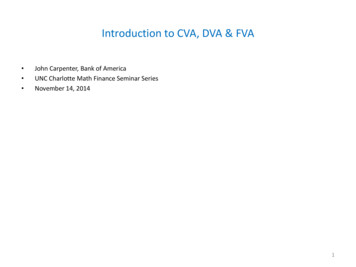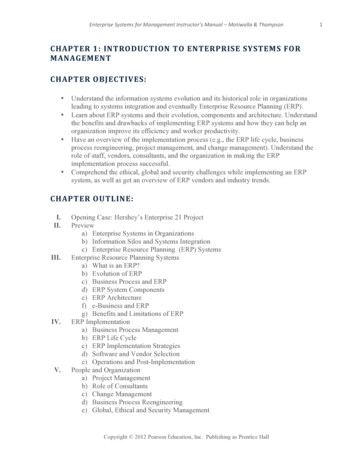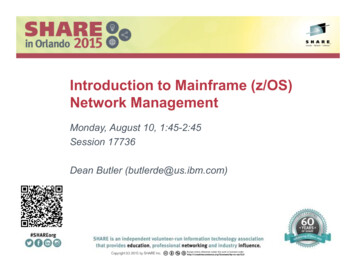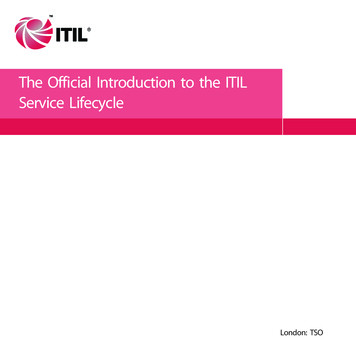
Transcription
Introduction to CVA, DVA & FVA John Carpenter, Bank of AmericaUNC Charlotte Math Finance Seminar SeriesNovember 14, 20141
Example Interest Rate Swap Trades Dealer acts as market-maker in 10-year Interest Rate Swaps–Notional 100,000,000DV01 91,000. Dealer covers a client flow in inter-bank market.2.50%DealerClient ALIBOR2.51%LIBOR CompetitorInterest Rates increase 10bps. P&L is maintained but––Dealer now has credit exposure to Client ACompetitor has credit exposure to dealerT0:CounterpartyClient A Competitor MTMRisk91,000 91,000 (91,000)91,000 -T1:CounterpartyClient A Competitor MTM910,000 (819,000) 91,000 Risk91,000(91,000)-What if Client A defaults?Exposure not as simple as a pure asset/liability, with a derivative can be /- andfluid2
Example Interest Rate Swap Trades Even without market moves, if forwards are followed, exposure evolves after T0Forward profile has expectation that MTM will be non-zero over timeMTM of IRS 100mm 10y 4,500,000 4,000,000 3,500,000 3,000,000 2,500,000 2,000,000 1,500,000 1,000,000 500,000 v-22Nov-23Nov-243
Credit Support Annex (“CSA”) Describes collateral arrangement between derivative counterpartiesCounterparty A w/ negative Mark to Market (“MTM”) posts cash to Counterparty BCounterparty B pays interest on that cash to Counterparty ANet credit exposure changes with MTM of underlying derivativesMultiple trades are typically netted under a master ISDAInterdealer market typically OIS – zero thresholds (“standard CSA”)Sometime currency optionality (can post EUR or USD)Customer trades may not be standard––––Complete absence (legacy trades)One way (only bank posts, govts, supranationals)ThresholdsRehypothecation Not natural for cash management for non-financial customersSovereigns, MunisEven perfect CSAs have closeout risk (2 weeks – used in capital models) Expected return of the MTM of a cashflow determines discount rateLed to transition from LIBOR to OIS discounting4
Credit Valuation Adjustment (“CVA”) – In the Pricing/Value Sense Present value of expected losses on derivative MTM due to counterparty defaultValue of difference between Actual CSA and Standard CSACaptures expected cost of hedging counterparties’ default risk– If CDS/risky bonds not available, internal spread matrix based on ratingsAlways requires dynamic replication strategy– Typically exposure hedged at least partially with credit default swaps (CDS)Credit exposure changes as the MTM of the underlying derivativeSimple approaches are possible for non-banks (“current exposure” methods)Banks must use Expected Potential Exposure methodsFAS 157 – included in earnings5
CVA Credit Charge Pricing and Risk Simple products become complexAmerican option style payout – contingent on creditExpected Positive Exposure (“EPE”), PD is default probability 𝐶𝑉𝐴 1 𝑅𝑒𝑐𝑜𝑣𝑒𝑟𝑦 Short an option to your counterparty,––𝑡 𝑇𝐸𝑃𝐸(t)𝑡 0* PD(t,t dt) dtCounterparty can walk away from a negative derivative MTM at any future timeCVA is present value of that series of options, weighted by probability of c/p default in that interval Must be done in a portfolio context – netting sets, Monte Carlo These CVA charges change over time based on derivative and credit spreadsMust be hedgedWill generate deltas/vegas etc in the underlying risk factorsDeep in-the money FX option with counterparty with a 50% default probabilityPV riskfree (FX – K)* RFDF, PV risky (FX – K)*RFDF*50%,Risky Foreign currency leg PV is 50% of the Risk Free PV, therefore the risky derivativeshould be hedged with approx half the notional of the same derivative with a risk-freecounterparty (assuming no recovery)6
Correlation Adjustment (1) Standard Intensity (“hazard rate”) modelInstantaneous default probability λ. 𝑢 𝑡 λ(u) du-λ𝑡𝑢 0Survival probability at time t: S(t) eor S(t) eDefine Indicator function ① to be 0 if in default, 1 otherwiseAn expected cashflow V(S) from a risky counterparty becomes E[① * V(S) ]Normal approach is to calibrate ① off of CDS prices and discount risky cashflowsDoes not work when value of cashflow V(S) and ① have covarianceE[① * V(S) ] E[① ] * E[V(S) ] when Cov ( V(S), ① ) 0Similar to “Quanto Adjustment” Substantially affects pricing complexity.How do you calibrate correlations?7
Correlation Adjustment (2) “Right Way Risk”––– “Wrong Way Risk”––– Counterparty’s spreads widen in same environment when they owe you more moneyCosts more to buy more protection as derivative increase MTMCross currency swap receiving USD, paying RUB facing a Russian BankSometimes not clear whether “right way or wrong way”–– Counterparty’s spreads tighten in same environment when they owe you more moneyCommodity deriv contract with an oil producer -- client sells calls on oil, buy the putsBank is owed money on the MTM of derivative when oil is higher (counterparty in good shape)Idiosyncratic credit event or market eventLarge economic events disrupt underlying markets and credit risk simultaneouslyBeware of Brownian Motion Diffusion Models, market tends to gap in stress8
CVA desk in practice Internal CVA desk assumes/manages contingent credit riskNatural offsets (one desk positive MTM, another negative to counterparty)Centralization of expertise, monitoring, reportingData challenges – CSA terms, legal entities, netting sets, grace periodsAttempt to hedge counterparty risk (via CDS and Securitization) where possibleResidual market risk where possibleCharges derivative trading desk a feeFee then passed to customerIf counterparty defaults, CVA desk pays derivative desk the MTM of the transactionChallenges: Liquidity/Availability of CDS is benign and stressed environmentUnhedgeble correlation risksNeed experienced traders, sometimes “right-way” or “wrong-way” not obvious9
Capital Requirements for CVA (CVA VaR) Volatility of CVA during crisis (realized defaults MTM volatility from creditspreads)Basel III – capital charge on CVA volatilityCEM and EPE – Standardized or Monte Carlo approachCredit hedges “count” against charges but not market hedgesPFE – based on tails of distribution (95% or 99% confidence interval)––– Similar to VARUsed for allocating capital, not pricing or risk managementImportant for monitoring counterparty limitsBasel “Advanced” Methodology10
Industry Shift to Central Clearing LCH, CMETypically fully collateralized for variation margin with additional high initial marginCounterparty risk replaced by clearing house Required for many products (IRS, CDS) and counterparties (dealer to dealer)Only handles standard conventionsSome corporates exemptCounterparty A w/ negative Mark to Market (“MTM”) posts cash to Clearing HouseCSA with clearing house “standard”, also has “initial amount”11
Debit Valuation Adjustment (“DVA”) Opposite of CVA – reflects risk of own default.Symmetrical Pricing (My DVA is your CVA) in theory (net of model diffs)–– Structured Notes Under Fair Value OptionHas perverse dynamic – gains when your credit is deteriorating, losses inimprovementTricky to hedge–––– Same credit adjusted pricesRisk Free DVA - CVACan’t sell protection on yourselfProbably need the funding most when spreads are wideningDifficult to buyback debt (tenders, timing)Could sell on peers but difficult in size, increased risk, Volker implicationsAffect earnings, Excluded from Capital12
Funding Value Adjustment (“FVA”) Defined Suppose an uncollateralized trade with a client is hedged with a collateralized streetfacing tradeIf MTM of hedge becomes negative:–– Dealer must post collateral to street counterparty,Does not receive collateral from clientWhat is the cost to fund that collateral?–Collateral will return OIS, but cannot be raised at OIS, raised at average cost of funds Implicitly it is a loan to the client (direction could be reversed be a deposit)Incremental to CVA because dealer must raise cash and buy default protection on client FVA Adjustment to derivative price which reflects the economic value of funding At what price should a dealer trade an uncollateralized derivative with implied funding?Funding costs must be considered, or could end up with a large and expensive fundingrequirement Two different banks will have different prices for the same derivative, depending onfunding costs13
FVA in theory Still widely debated in both academia and industryHow to separate funding component from expected default component.How to combine consistently with CVA/DVA and avoid double counting?–– Especially difficult with DVA, DVA FVA should not exceed total spread on debt.Which default occurs first?The banks credit worthiness is a function of the quality of its assets.Suppose bank has only one derivative asset, bank’s credit should equal counterparty’s.The cost of the bank’s debt would include CVA FVA and so counterparty would getdouble CVA.Should corporation’s own debt be discounted risk free? The risk free PV of its extraexpense over risk free is not NPV on balance sheet?Should a risky corporation lend money a less risky counterparty?A corporate bond held in a bank’s asset portfolio would not have funding risk valued.Why is a derivative receivable different?Mathematically complex to have unified frameworkTheoretical arguments based on trading in ones own debt -- not practical––Tender requirements, blackout, regulatory, liquidity/funding plansBenchmark size, Investor expectations of issuance pattern14
FVA in practice Some banks have made one-time adjustments for net derivative receivable positions (JPMorgan Q4 2013) No prescriptive accounting standard How to avoid double counting and price competitively?Reducing volatility in earnings (diversifies) DVA––– Effective lifetime also important– Unwinds and restructuring of client tradesPortfolio effects – need centralized deskHow to separate funding from default risk? (bond / cds basis?)– Typical FVA position is long receivables from uncollateralized clientsDVA typically the reverse (net liability position from structured notes under FVO).Seen in initial disclosures (losses) when FVA switch is “turned on” (e.g., JPM 4q 2013)CDS illiquidity/volatility makes this of little practical useAlignment with Funds Transfer Pricing (static net funding req vs term structure)FVA benefit not a stable source of funds or accretive to regulatory metrics15
FVA – Counterarguments Hull and White (U. of Toronto)Their position – FVA should be ignored in pricing/valuationsRisk free rate is not used because assumption banks can fund at risk free rate–– FVA – Asymmetric nature- Two banks give different price for same uncollateralized derivative depending on banks funding costsPermits arbitrageShould corporation’s own debt be discounted risk free? No.Should a risky corporation lend money a less risky counterparty?- Used because risk-neutral valuation requires itRN valuation gives correct value adjusting for hedgeable market risksAnalogy, should banks give a loan at a price that reflects clients creditworthiness only?If not then never would lend to a better credit at any rate.Is it automatically in the price? FVA is the incremental DVA issued to fund collateralDecision to hedge shouldn’t affect valuations.Corporate Finance Principle: pricing separate from funding16
References and Further Reading “The FVA Debate”, Hull and White“Is FVA a Cost for Derivatives Desks?”, Hull and White“FVA – Putting Funding into the Equation”, KPMG“Credit Value Adjustment and Funding Value Adjustment All Together”, Lu and Juan“CVA, DVA & Bank Earnings”, Kelly and Pugachevsky“The Impact of FVA on swaps: A primer”, Pugachevsky“Managing the Complexities of CVA, DVA and FVA”, Pugachevsky“The FVA-DVA Puzzle: Risk Management and Collateral Trading Strategies”,Albanese and Iabichino“Credit valuation adjustments for derivative contracts”, Ernst & Young“Yes, FVA is a Cost for Derivatives Desk”, Castagna“Counterparty Risk FAQ:”, Brigo17
– CVA is present value of that series of options, weighted by probability of c/p default in that interval Must be done in a portfolio context – netting sets, Monte Carlo These CVA charges change over time based on derivative and credit spreads Must be hedged Will generate deltas/vegas etc in the underlying risk factors Deep in-the money FX option with counterparty with .











